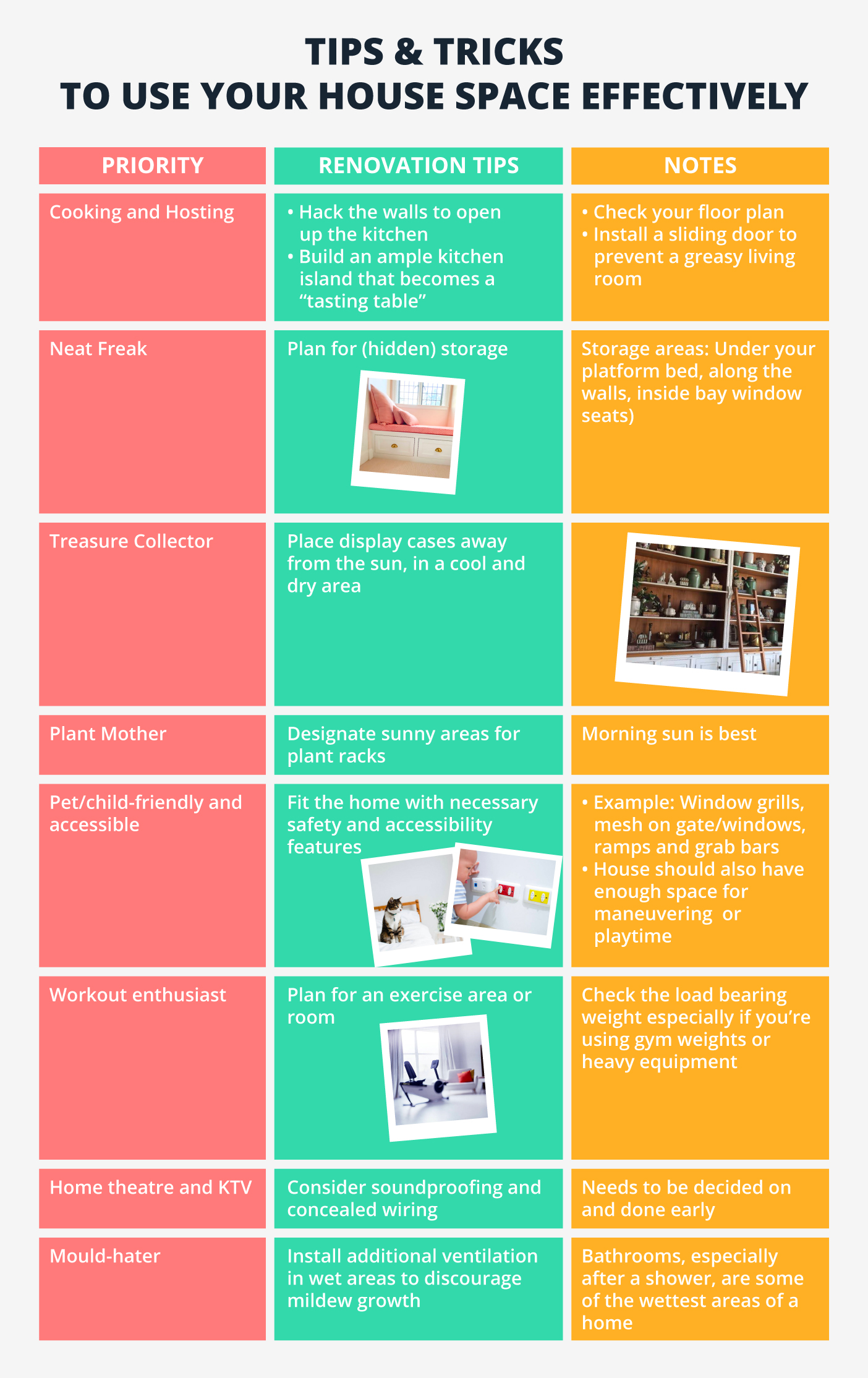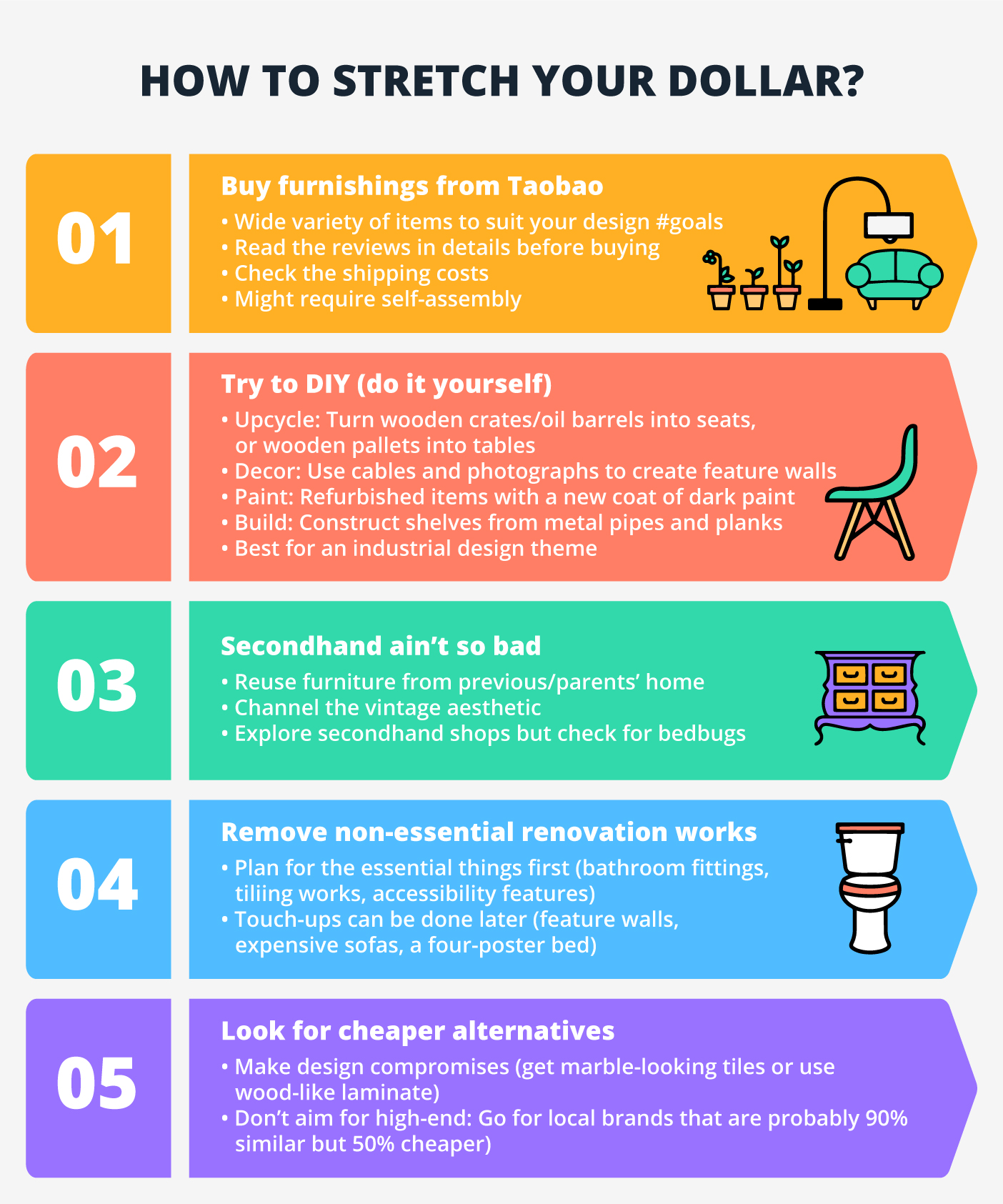![]()
If you’ve only got a minute:
- Assess your needs and preferences to create a clear vision of the renovation.
- Set a budget and prioritise essential upgrades to avoid overspending.
- Have a think about how you will finance your renovations and the impact on your cashflow
![]()
Congratulations! Now that you’ve collected the keys to your new place, it’s time to embark on your home renovation journey.
Renovation is a big decision as it involves a lot of money, planning and effort - and if you’re not the sole owner of the apartment, a collective agreement from all homeowners will likely be necessary.
Before you get carried away with the aesthetics and interior design choices, here are 5 important considerations to help you better plan your renovation.
1. How do you envision using your newfound space?
You may be eyeing a trending interior design, but let’s face it, most homes in Singapore are small, so it’s always best to prioritise the effective use of your newfound space. You also want to refrain from making changes in the midst of the renovation process as any unplanned modifications will certainly add to the final bill.
Here are some thought-starters.
What activities will your new home be designed for?
Will it cater to activities like hosting and cooking for friends, Netflix sessions or daily yoga routines? Do you require a dedicated space to work or study from home? By assessing these requirements, you’ll be able to tailor the renovation to suit your lifestyle and preferences. If you plan to entertain guests frequently, allocating adequate space for a welcoming living area and a functional kitchen should be prioritised.
Who/what will be sharing the space with you?
Think about the occupants and elements that will coexist in your space. Are pets, plants or children going to be a part of your household? Consider the needs of family members, such as accommodating to the needs of an elderly mother-in-law, if required. These will help you design a space to accommodate everyone comfortably.
These considerations could also influence the overall design vibe of your home.

2. How hands-on do you want to be?
How involved do you want to be in your renovation? Are you savvy about renovation matters? How much time do you have to spare?
When it comes to home renovations, the level of hands-on involvement depends on your preferences, the complexity of the project, your budget, and your personal expertise. Here's a breakdown of the different options:
Individual contractors (you manage your renovation project)
This option is typically more cost-effective, but time-consuming. It requires you to have a good understanding of the construction and renovation process. You'll likely have to oversee various aspects of the project, including design, sourcing materials, coordinating trades, and managing timelines.
Design-and-build company
These days, many contractors are also working like interior designers - they help to manage your renovation project, but at a rate slightly lower than those with top-notch design experience. It’s good if you want something tried-and-tested, with tons of reference photos available online. If you’re a designer yourself, this collaboration works really well. While this is potentially the middle-ground for your wallet, expensive materials and complicated works could also drive up the total cost.
Interior design (ID) firm
When you decide to work with an interior design firm, you are essentially outsourcing the design and management of your renovation project. This option is ideal for those who have busy schedules or prefer not to deal with the intricacies of the renovation process.
While using an interior design firm offers a seamless and professionally managed experience, it tends to be more costly. However, for those seeking a high-quality, well-designed space without having to oversee every detail, an interior design firm can provide a luxurious and hassle-free renovation journey.
Discover inspiring interior home design ideas and get matched with trusted local interior firms from our partners on DBS Home Marketplace, plus, get free quotations now!

3. Will this be your forever home?
People buy properties for various reasons: To live in, as an investment, or even as a stepping stone to a better property. Your intended duration of stay can significantly impact your renovation plans.
Planning to sell/upgrade to a private property?
If you plan to sell after the minimum occupancy period, a simple renovation should suffice since buyers may potentially renovate again.
For income/investment
If you’re planning to earn rental on the property, a generic, neutral design might be best to suit any future tenants’ tastes.
It’s your forever home
If the intent is to live there forever, consider thoughtful upgrades to create a comfortable, durable, and personalised living space - structural improvements, higher quality finishes and customised details that can stand the test of time.
For instance, depending on the condition of the existing property structure, you might consider changes like knocking down of walls for an open-concept layout. Prioritise materials and designs that are easy to maintain and durable to minimise the need for frequent repairs. Integrating smart home technology for convenience and security is also becoming increasingly popular.

4. What budget are you working with?
Your budget is a crucial factor in your interior design plans. Research the costs associated with your renovation and determine your renovation priorities. Consider allocating a portion of your budget for materials and finishes, such as flooring, cabinets, countertops, fixtures, and lighting. High-quality materials may cost more but can add value to your home.
Thankfully, there are some ways to keep your grand renovation plans within budget. Here are some tips.

5. How will you finance the renovation?
There are many ways to finance your renovation. Here are some common options, along with some pros and cons.
Cash
Using your personal savings is the most straightforward way to finance a renovation. This approach avoids interest costs and debt. However, do ensure you have sufficient savings set aside for both the renovation and furnishings.
Bank renovation loan
Homeowners sometimes choose to take up a renovation loan even when they have cash readily available for several reasons. Besides liquidity matters, some prefer to invest their cash in higher-return investments rather than using it for a renovation. If the return on their investments exceeds the interest rate on the renovation loan, they can potentially save more money.
Additionally, renovation loans allow homeowners to manage their budgets more effectively by spreading the renovation costs over time. This can be especially helpful for larger-scale projects.
Banks typically offer competitive rates on their renovation loans compared to a personal loan, along with perks such as preferential rates and/or synergy with other products.
At DBS, enjoy attractive interest rates of 5.08% p.a. (EIR 6.16% p.a.) with the DBS Renovation Loan and 4.88% p.a. (EIR 5.96% p.a.) with the DBS Eco-aware Renovation Loan, based on a S$30,000, 5-year loan. To qualify, fulfil any 6 items under the “Eco-aware Renovation Checklist” in the application form.
Find out more here: DBS Renovation Loans
Mix of cash and renovation loan
Not everything can be covered by the renovation loan. As long as something is not included in the ID/contractor’s quote, it’s likely not covered and you will need to fork out the cash. Furnishings, which can cost up to or more than your renovation amount, is not included in the renovation loan.
In addition, bank renovation loans typically set a limit on how much money can be disbursed, usually up to 6 times the borrower’s monthly salary or S$30,000, whichever is lower. While this could potentially be doubled to S$60,000 if you have a co-owner, if you’re renovating a resale flat, it might not be enough.
For these scenarios, a personal loan can help. Personal loans are unsecured loans that can be used for various purposes, including home renovations. Interest rates for personal loans can be higher than other options, so it's important to compare rates and terms.
Find out more: POSB Cashline
Find out more: DBS Personal Loan

Check before you leap
As always, before making a major life or financial decision, make sure you do all your calculations and planning before taking the plunge. Most importantly, remember to keep an open mind. Renovation works, like all major projects, could have hiccups here and there.
Make use of DBS MyHome Planning tools to easily check your affordability, cashflow timeline and search for a suitable unit.
Alternatively check out DBS Home Marketplace, a one-stop-solution for homeowners and buyers. Find all the information and tools you need to help build your dream home.





